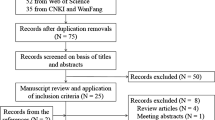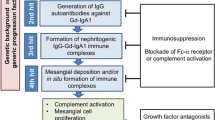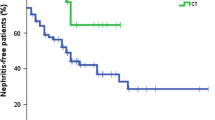Abstract
Background
Hypertension, which is affected by genetic and environmental factors, is one of the major risk factors for chronic kidney disease. Identification of the genetic factor contributing to hypertension in patients with chronic kidney disease may potentially refine a therapeutic strategy.
Methods
In the present multicenter cross-sectional study, 240 patients were eligible (aged 15–50 years with urinary protein ≥0.25 g/day) out of 429 patients who were diagnosed as having immunoglobulin (Ig) A nephropathy (IgAN) by renal biopsy between 1990 and 2005 and enrolled in our previous study, PREDICT-IgAN. The outcome was hypertension defined as ≥140 and/or ≥90 mmHg of systolic and diastolic blood pressure and/or use of antihypertensives at renal biopsy. We assessed associations between hypertension and 28 polymorphisms with the frequency of minor genotype ≥10% among 100 atherosclerosis-related polymorphisms using the Chi-squared test in dominant and recessive models. We identified polymorphisms associated with hypertension in multivariate logistic regression models.
Results
Baseline characteristics: hypertension 36.3%. Among 28 polymorphisms, the Chi-squared test revealed that CD14 (-159CC vs CT/TT, P = 0.03) and ACE (DD vs DI/II, P = 0.03) were significantly associated with hypertension after Bonferroni correction. Multivariate logistic regression models revealed that CD14 -159CC [vs CT/TT, odds ratio (OR) 3.58 (95% confidence interval (CI) 1.66–7.63)] and ACE DD [vs DI/II, OR 4.41 (95% CI 1.80–10.8), P = 0.001] were independently associated with hypertension.
Conclusions
CD14 C-159T and ACE I/D contributed to hypertension in patients with IgAN.
Similar content being viewed by others
References
Barsoum R. Chronic kidney disease in the developing world. N Engl J Med. 2006;354(10):997–9.
System. USRD. USRDS 2008 annual data report: atlas of end-stage renal disease in the United States. National Institute of Diabetes and Digestive and Kidney Diseases, 2008; 2009.
Wiwanitkit V. Angiotensin-converting enzyme gene polymorphism is correlated to the progression of disease in patients with IgA nephropathy: a meta-analysis. Ren Fail. 2006;28(8):697–9.
Koomans H, Roos J, Boer P, Geyskes G, Mees E. Salt sensitivity of blood pressure in chronic renal failure. Evidence for renal control of body fluid distribution in man. Hypertension. 1982;4(2):190–7.
Farmer C, Goldsmith D, Cox J, Dallyn P, Kingswood J, Sharpstone P. An investigation of the effect of advancing uraemia, renal replacement therapy and renal transplantation on blood pressure diurnal variability. Nephrol Dial Transplant. 1997;12(11):2301–7.
Hering D, Zdrojewski Z, Król E, Kara T, Kucharska W, Somers V, et al. Tonic chemoreflex activation contributes to the elevated muscle sympathetic nerve activity in patients with chronic renal failure. J Hypertens. 2007;25(1):157–61.
Schiffrin EL, Lipman ML, Mann JF. Chronic kidney disease: effects on the cardiovascular system. Circulation. 2007;116(1):85–97.
Hausberg M, Grassi G. Mechanisms of sympathetic overactivity in patients with chronic renal failure: a role for chemoreflex activation? J Hypertens. 2007;25(1):47.
Chanda R, Fenves A. Hypertension in patients with chronic kidney disease. Curr Hypertens Rep. 2009;11(5):329–36.
Wright J, Hutchison A. Cardiovascular disease in patients with chronic kidney disease. Vasc Health Risk Manag. 2009;5:713–22.
Burt V, Whelton P, Roccella E, Brown C, Cutler J, Higgins M, et al. Prevalence of hypertension in the US adult population: results from the Third National Health and Nutrition Examination Survey, 1988–1991. Hypertension. 1995;25(3):305–13.
Kearney P, Whelton M, Reynolds K, Muntner P, Whelton P, He J. Global burden of hypertension: analysis of worldwide data. Lancet. 2005;365(9455):217–23.
Kosugi T, Nakagawa T, Kamath D, Johnson R. Uric acid and hypertension: an age-related relationship? J Hum Hypertens. 2009;23(2):75–6.
Yatsu K, Mizuki N, Hirawa N, Oka A, Itoh N, Yamane T, et al. High-resolution mapping for essential hypertension using microsatellite markers. Hypertension. 2007;49(3):446–52.
Koyama A, Igarashi M, Kobayashi M. Natural history and risk factors for immunoglobulin A nephropathy in Japan. Research Group on Progressive Renal Diseases. Am J Kidney Dis. 1997;29(4):526–32.
D’Amico G. Natural history of idiopathic IgA nephropathy: role of clinical and histological prognostic factors. Am J Kidney Dis. 2000;36(2):227–37.
Yamamoto R, Nagasawa Y, Shoji T, Iwatani H, Hamano T, Kawada N, et al. Cigarette smoking and progression of IgA nephropathy. Am J Kidney Dis. 2010;56(2):313–24.
Yamamoto R, Nagasawa Y, Shoji T, Inoue K, Uehata T, Kaneko T, et al. A candidate gene approach to genetic prognostic factors of IgA nephropathy—a result of Polymorphism REsearch to DIstinguish genetic factors Contributing To progression of IgA Nephropathy (PREDICT-IgAN). Nephrol Dial Transplant. 2009;24(12):3686–94.
Matsuo S, Imai E, Horio M, Yasuda Y, Tomita K, Nitta K, et al. Revised equations for estimated GFR from serum creatinine in Japan. Am J Kidney Dis. 2009;53(6):982–92.
Yamada Y, Izawa H, Ichihara S, Takatsu F, Ishihara H, Hirayama H, et al. Prediction of the risk of myocardial infarction from polymorphisms in candidate genes. N Engl J Med. 2002;347(24):1916–23.
Walton K, Hsieh X, Gharavi N, Wang S, Wang G, Yeh M, et al. Receptors involved in the oxidized 1-palmitoyl-2-arachidonoyl-sn-glycero-3-phosphorylcholine-mediated synthesis of interleukin-8: a role for Toll-like receptor 4 and a glycosylphosphatidylinositol-anchored protein. J Biol Chem. 2003;278(32):29661–6.
Hasday JD, Bascom R, Costa JJ, Fitzgerald T, Dubin W. Bacterial endotoxin is an active component of cigarette smoke. Chest. 1999;115(3):829–35.
Michel O, Kips J, Duchateau J, Vertongen F, Robert L, Collet H, et al. Severity of asthma is related to endotoxin in house dust. Am J Respir Crit Care Med. 1996;154(6 Pt 1):1641–6.
Wiedermann CJ, Kiechl S, Dunzendorfer S, Schratzberger P, Egger G, Oberhollenzer F, et al. Association of endotoxemia with carotid atherosclerosis and cardiovascular disease: prospective results from the Bruneck Study. J Am Coll Cardiol. 1999;34(7):1975–81.
Raunio T, Knuuttila M, Karttunen R, Vainio O, Tervonen T. Serum sCD14, polymorphism of CD14(-260) and periodontal infection. Oral Dis. 2009;15(7):484–9.
Amar J, Ruidavets JB, Bal Dit Sollier C, Bongard V, Boccalon H, Chamontin B, et al. Soluble CD14 and aortic stiffness in a population-based study. J Hypertens. 2003;21(10):1869–77.
Pacheco E, Fonseca C, Montes C, Zabaleta J, Garca LF, Arias MA. CD14 gene promoter polymorphism in different clinical forms of tuberculosis. FEMS Immunol Med Microbiol. 2004;40(3):207–13.
Lin J, Yao YM, Yu Y, Chai JK, Huang ZH, Dong N, et al. Effects of CD14-159 C/T polymorphism on CD14 expression and the balance between proinflammatory and anti-inflammatory cytokines in whole blood culture. Shock. 2007;28(2):148–53.
Zee RY, Bates D, Ridker PM. A prospective evaluation of the CD14 and CD18 gene polymorphisms and risk of stroke. Stroke. 2002;33(4):892–5.
Risley P, Jerrard-Dunne P, Sitzer M, Buehler A, von Kegler S, Markus HS. Promoter polymorphism in the endotoxin receptor (CD14) is associated with increased carotid atherosclerosis only in smokers: the Carotid Atherosclerosis Progression Study (CAPS). Stroke. 2003;34(3):600–4.
Staessen J, Wang J, Ginocchio G, Petrov V, Saavedra A, Soubrier F, et al. The deletion/insertion polymorphism of the angiotensin converting enzyme gene and cardiovascular-renal risk. J Hypertens. 1997;15(12):1579.
Shinoda H, Nishimoto K, Mochizuki T. Screening examination of Trichophyton tonsurans among Judo practitioners at the All Japan Inter High School Championships, Saga 2007. Nippon Ishinkin Gakkai Zasshi. 2008;49(4):305–9.
Xie Y, Chen X, Nishi S, Narita I, Gejyo F. Relationship between tonsils and IgA nephropathy as well as indications of tonsillectomy. Kidney Int. 2004;65(4):1135–44.
Iio K, Nagasawa Y, Iwatani H, Yamamoto R, Horii A, Okuzaki D, et al. Microarray analysis of tonsils in immunoglobulin A nephropathy patients. Biochem Biophys Res Commun. 2010;393(4):565–70.
Suzuki S, Nakatomi Y, Sato H, Tsukada H, Arakawa M. Haemophilus parainfluenzae antigen and antibody in renal biopsy samples and serum of patients with IgA nephropathy. Lancet. 1994;343(8888):12–6.
Suzuki S, Fujieda S, Sunaga H, Sugimoto H, Yamamoto C, Kimura H, et al. Immune response of tonsillar lymphocytes to Haemophilus parainfluenzae in patients with IgA nephropathy. Clin Exp Immunol. 2000;119(2):328–32.
Barratt J, Feehally J. IgA nephropathy. J Am Soc Nephrol. 2005;16(7):2088–97.
Appel GB, Waldman M. The IgA nephropathy treatment dilemma. Kidney Int. 2006;69(11):1939–44.
Port FK, Eknoyan G. The Dialysis Outcomes and Practice Patterns Study (DOPPS) and the Kidney Disease Outcomes Quality Initiative (K/DOQI): a cooperative initiative to improve outcomes for hemodialysis patients worldwide. Am J Kidney Dis. 2004;44(5 Suppl 2):1–6.
Isnard Bagnis C, Deray G, Baumelou A, Le Quintrec M, Vanherweghem JL. Herbs and the kidney. Am J Kidney Dis. 2004;44(1):1–11.
Acknowledgments
This study was supported by grant-in-aid for Young Scientists B (21790809), grant-in-aid for Scientific Research C (22590891), and grant from Osaka Kidney Bank (OK-3, 2009) and a travel grand from XLVII European Renal Association—European Dialysis Transplantation Association (ERA-EDTA) Congress in 2010.
Conflict of interest
None.
Author information
Authors and Affiliations
Corresponding author
About this article
Cite this article
Shinzawa, M., Yamamoto, R., Nagasawa, Y. et al. Gene polymorphisms contributing to hypertension in immunoglobulin A nephropathy. Clin Exp Nephrol 16, 250–258 (2012). https://doi.org/10.1007/s10157-011-0553-7
Received:
Accepted:
Published:
Issue Date:
DOI: https://doi.org/10.1007/s10157-011-0553-7




